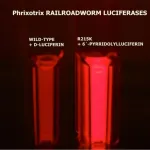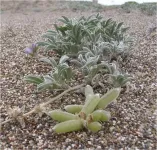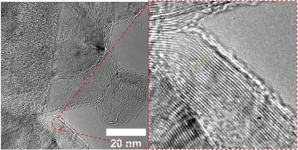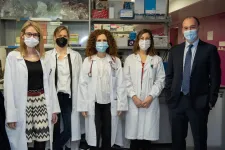Brazilian researchers obtain more efficient red bioluminescence
Luciferin-luciferase system developed in collaboration with Japanese researchers produces brighter and longer-lasting far red light. The innovation can be used to image cells and tissues for diagnosis and biomedical research.
2021-03-29
(Press-News.org) Researchers at the Federal University of São Carlos (UFSCar) in the state of São Paulo, Brazil, have developed a novel far red light-emitting luciferin-luciferase system that is more efficient than those available commercially. An article on the subject is published in the International Journal of Molecular Sciences.
The study was supported by São Paulo Research Foundation - FAPESP via the Thematic Project "Arthropod bioluminescence: biological diversity in Brazilian biomes, biochemical origin, structural/functional evolution of luciferases, molecular differentiation of lanterns, biotechnological, environmental and educational applications", for which the principal investigator is Vadim Viviani, a biochemist and professor at UFSCar.
"We obtained a novel luciferin-luciferase system that produces far red light at the wavelength of 650 nanometers and emits the brightest bioluminescence ever reported in this part of the spectrum. It's a highly promising result for bioluminescence imaging of biological and pathological processes in mammalian tissues," Viviani told.
Luciferases are enzymes that catalyze the oxidation of luciferins, compounds present in some animals, algae and fungi. The oxidation reaction is responsible for the phenomenon of bioluminescence, which consists of the emission of light at wavelengths ranging from blue to red.
The firefly's luciferin-luciferase system is widely used to help produce images of cell cultures and live animal models. It helps physicians monitor metastasis, for example, and see how tumors respond to treatment. It is also used to follow the viral infection process and the effects of candidate drugs on viruses, including the novel coronavirus.
"Red bioluminescence is preferred when imaging biological or pathological processes in mammalian tissues because hemoglobin, myoglobin and melanin absorb little long-wavelength light. Detection is best of all in the far red and near-infrared bands, but bioluminescent systems that naturally emit far red light don't exist," Viviani said.
"Some genetically modified forms of luciferase and synthetic analogs of natural luciferins are produced commercially. In conjunction, they produce light at wavelengths as long as 700 nanometers, but the light produced by these artificial systems is generally much weaker and more short-lived than light from natural bioluminescent systems."
Viviani and collaborators used genetic engineering to modify luciferase from the Railroad worm Phrixothrix hirtus, the only luciferase that naturally emits red light, cloned by Viviani two decades ago. This they combined with luciferin analogs synthesized by colleagues at the University of Electro-Communications in Tokyo, Japan. The result was a much more efficient far red luciferin-luciferase system.
"Our best combination produces far red at 650 nanometers, three times brighter than natural luciferin and luciferase, and roughly 1,000 times brighter than the same luciferase with a commercial analog," Viviani said.
"Besides the long wavelength and intense brightness, our combination has better thermal stability and cell membrane penetrability. Above all, it produces more lasting continuous bioluminescence, taking at least an hour to decay and significantly facilitating the real-time imaging of biological and pathological processes."
INFORMATION:
The project was a continuation of a PhD thesis recently defended by Vanessa Bevilaqua on the effect of synthetic luciferin analogs on red luciferase from Phrixothrix. The other co-authors are PhD candidate Daniel Sousa, Gabriel Pelentir with a scientific initiation grant, and Michio Kakiuchi and Takashi Hirano in Japan.
About São Paulo Research Foundation (FAPESP)
The São Paulo Research Foundation (FAPESP) is a public institution with the mission of supporting scientific research in all fields of knowledge by awarding scholarships, fellowships and grants to investigators linked with higher education and research institutions in the State of São Paulo, Brazil. FAPESP is aware that the very best research can only be done by working with the best researchers internationally. Therefore, it has established partnerships with funding agencies, higher education, private companies, and research organizations in other countries known for the quality of their research and has been encouraging scientists funded by its grants to further develop their international collaboration. You can learn more about FAPESP at http://www.fapesp.br/en and visit FAPESP news agency at http://www.agencia.fapesp.br/en to keep updated with the latest scientific breakthroughs FAPESP helps achieve through its many programs, awards and research centers. You may also subscribe to FAPESP news agency at http://agencia.fapesp.br/subscribe.
[Attachments] See images for this press release:

ELSE PRESS RELEASES FROM THIS DATE:
2021-03-29
ANN ARBOR--In a two-year study that could help guide educators developing the post-pandemic new normal, student groups at the University of Michigan assigned to make video presentations showed more creativity and risk-taking than groups making conventional in-person presentations.
"Given the importance of project-based learning, our study provides a way to turn virtual limitations into an advantage," said Fei Wen, U-M associate professor of chemical engineering. "We can enhance the student experience and learning outcomes."
Higher education, along with society at large, anticipates a shift in the balance between ...
2021-03-29
More physicians and pharmacists are advocating for patients to be made aware of animal byproducts contained in common medications, according to new research in the Journal of Osteopathic Medicine. Common medications, including widely used blood thinners and hormones, are often derived from animal byproducts and prescribed without consulting the patient about their beliefs.
"Patients deserve to know what their medications are made of, yet this information is rarely shared," said Sara Reed, student doctor at Lincoln Memorial University (LMU) DeBusk ...
2021-03-29
Climate change is altering the world we share with all living things. But it's surprisingly difficult to single out climate change as an extinction threat for any one particular species protected under the Endangered Species Act.
To date, the U.S. Fish and Wildlife Service has only formally considered impacts from climate change in listing actions for four animal species and one alpine tree.
But the effects of climate change extend to temperate climates as well. A new analysis of population data published in the journal Ecosphere shows that climate change represents a specific extinction threat for an endangered coastal lupine plant.
Biologists including Eleanor Pardini at Washington University in St. Louis have tracked all of the known stands ...
2021-03-29
HOUSTON - (March 29, 2021) - This could be where the rubber truly hits the road.
Rice University scientists have optimized a process to convert waste from rubber tires into graphene that can, in turn, be used to strengthen concrete.
The environmental benefits of adding graphene to concrete are clear, chemist James Tour said.
"Concrete is the most-produced material in the world, and simply making it produces as much as 9% of the world's carbon dioxide emissions," Tour said. "If we can use less concrete in our roads, buildings and bridges, we can eliminate some of the emissions at the very start."
Recycled tire waste is already used as a component of Portland cement, but graphene has been proven to strengthen cementitious materials, ...
2021-03-29
SUVA, Fiji (March 29, 2021) - A new study published in the journal Environmental Science and Policy addresses the impacts of COVID-19 and Cyclone Harold on Indo-Fijians engaged in small scale fisheries.
The paper says that countries, including Fiji, need to address ethical and social justice considerations and the politics of recovery efforts by putting vulnerable and marginalized groups front and center in the aftermath of pandemics and natural disasters.
What countries cannot afford is for economic recovery efforts to put additional burdens and risk on those invested in the SSF sector, and cause further widening of inequities, and increase ...
2021-03-29
A new study out of the University of Chicago and the University of Illinois Urbana-Champaign in humans, chimpanzees, rhesus macaques and baboons has found key differences in early gene expression in response to pathogen exposure, highlighting the importance of choosing the right animal model for the right questions. The study was published on March 26 in END ...
2021-03-29
A national survey of parents revealed that most parents who used ride-share services did so with their children, but only half of the respondents reported that children who were 8 years or younger traveled in the recommended child car seats or booster seats when in ride-share vehicles. Among parents of children in this age group, over 40 percent used only a seat belt for their child, while 10 percent allowed their child to travel on a lap or unrestrained. Overall, parents reported lower rates of child car seat use in ride-share compared with how their child usually travels. Findings were published in the journal Academic Pediatrics.
"Our results are concerning, as ...
2021-03-29
Barcelona researchers at the Hospital Clínic-IDIBAPS Research Institute, the University of Barcelona and the SOLTI academic cancer research group have shown that the molecular classification of breast cancer, which divides it into four subtypes (Luminal A, Luminal B, HER2-enriched and Basal-like) is useful for predicting the benefits of treatment in patients with advanced hormone-sensitive breast cancer. This is the largest study to have shown the value of the biomarker, and the first to do so in the context of a CDK4/6 inhibitor like ribociclib.
The study, published in the Journal of Clinical Oncology of the American Society of Clinical Oncology (ASCO), was coordinated by Professor Aleix Prat, head of the Medical Oncology ...
2021-03-29
CHAPEL HILL, NC - A team led by scientists at the UNC School of Medicine discovered an important vulnerability of the AIDS-causing retrovirus HIV, and has shown in preclinical experiments that a widely used diabetes drug, metformin, seems able to exploit this vulnerability.
The scientists, whose study is published in Nature Immunology, found that HIV, when it infects immune cells called CD4 T cells, helps fuel its own replication by boosting a key process in the cells' production of chemical energy. They also found that the diabetes drug metformin inhibits the same process and thereby suppresses HIV replication in these cells, in both cell-culture and mouse experiments.
"These findings suggest that metformin and other drugs that reduce T cell metabolism ...
2021-03-29
PHOENIX, Ariz. -- March 29, 2021 -- A review of more than 20 studies by researchers at Arizona State University and the Translational Genomics Research Institute (TGen), an affiliate of City of Hope, suggests that nonalcoholic fatty-liver disease (NAFLD) is a growing dietary problem for children across the globe.
"The prevalence of fatty-liver disease is escalating not only in adults, but also in children," said Johanna DiStefano, Ph.D., a Professor and head of TGen's Diabetes and Fibrotic Disease Unit, and the review's senior author. "Like type 2 diabetes, NAFLD used to be considered a disease that developed only in adulthood, ...
LAST 30 PRESS RELEASES:
[Press-News.org] Brazilian researchers obtain more efficient red bioluminescence
Luciferin-luciferase system developed in collaboration with Japanese researchers produces brighter and longer-lasting far red light. The innovation can be used to image cells and tissues for diagnosis and biomedical research.



